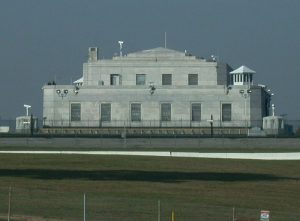Originally posted on Thursday, September 5th, 2013
Fort Knox, where much of the federal government’s gold is stored, is iconic and slightly mysterious, even cryptic. Actually, the gold is held in a US Treasury enclave within, but not part of, Fort Knox, called the United States Bullion Depository.
 Image courtesy of Wikipedia
Image courtesy of Wikipedia
It has a long and storied history, having also served as the depository of such assorted artifacts as St. Stephen’s crown, the original Declaration of Independence, Constitution, and Magna Carta. It also was used to store opium. According to the Wikipedia:
The United States Bullion Depository, often known as Fort Knox, is a fortified vault building located adjacent to Fort Knox, Kentucky, used to store a large portion of United States official gold reserves and occasionally other precious items belonging or entrusted to the federal government.
The United States Bullion Depository holds 4,578 metric tons (5,046.3 short tons) of gold bullion (147.2 million oz. troy). This is roughly 3 percent of all the gold ever refined throughout human history. Even so, the depository is second in the United States to the Federal Reserve Bank of New York‘s underground vault in Manhattan, which holds 7,000 metric tons (7,716 tons) of gold bullion (225.1 million oz. troy), some of it in trust for foreign nations, central banks and official international organizations.
In 1933, U.S. President Franklin D. Roosevelt issued Executive Order 6102, which outlawed the private ownership of gold coins, gold bullion, and gold certificates by American citizens, forcing them to sell these to the Federal Reserve. As a result, the value of the gold held by the Federal Reserve increased from $4 billion to $12 billion between 1933 and 1937.[2] This left the federal government with a large gold reserve and no place to store it. In 1936, the U.S. Treasury Department began construction of the United States Bullion Depository at Fort Knox, Kentucky, on land transferred from the military. The Gold Vault was completed in December 1936 for US $560,000 (this would cost $9,264,844 today). The site is located on what is now Bullion Boulevard at the intersection of Gold Vault Road. The building was listed on the National Register of Historic Places in 1988, in recognition of its significance in the economic history of the United States and its status as a well-known landmark.[3]
The first gold shipments were made from January to July 1937. The majority of the United States’ gold reserves were gradually shipped to the site, including old bullion and newly made bars made from melted gold coins. Some intact coins were stored. The transfer used 500 rail cars and was sent by registered mail, protected by the U.S. Postal Inspection Service, and the U.S. Treasury Department agents.
During World War II, the depository held the original U.S. Declaration of Independence and U.S. Constitution. It held the reserves of European countries and key documents from Western history; for example, it held the Crown of St. Stephen, part of the Hungarian crown jewels, given to American soldiers to prevent them from falling into Soviet hands. The repository held one of four copies (exemplifications) of the Magna Carta, which had been sent for display at the 1939 New York World’s Fair, and which, when war broke out, was kept in the United States for the duration.
During World War II and into the Cold War, until the invention of different types of synthetic painkillers, a supply of processed morphine and opium was kept in the Depository as a hedge against the United States being cut off from the sources of supply of raw opium.
Below the fortress-like structure lies the gold vault lined with granite walls and protected by a blast-proof door weighing 22 tons. Members of the Depository staff must dial separate combinations known only to them. Beyond the main vault door, smaller compartments provide further protection. …
The facility is ringed with fences and is guarded by the United States Mint Police. The Depository premises are within the site of Fort Knox, a United States Army post, allowing the Army to provide additional protection. The Depository is protected by layers of physical security, alarms, video cameras, mine fields, barbed razor wire, electric fences, heavily armed guards, and the Army units based at Fort Knox, including unmarked Apache helicopter gunships of 8/229 Aviation based at Godman Army Airfield, the 16th Cavalry Regiment, the 19th Engineer Battalion, formerly training battalions of the United States Army Armor School, and the 3rd Brigade Combat Team of the 1st Infantry Division, totaling 30,000 soldiers, with associated tanks, armored personnel carriers, attack helicopters, and artillery.
There is an escape tunnel from the lower level of the vault to be used by someone accidentally locked in.
For security reasons, no visitors are allowed inside the depository grounds. This policy has been enforced ever since the vault opened and the only exception was an inspection by members of the United States Congress and the news media on September 23, 1974 led by then Director of the United States Mint Mary Brooks.
It is to be wished that the officers of the Federal Reserve System would become as effective at securing the value of the dollar as the U.S. Mint Police are at securing the U.S. official gold reserves — preferably by defining the dollar as a fixed weight of gold. Properly done it would unleash a wave of American economic expansion that would surpass the value of all the US gold reserves, and quite possibly within a matter of months.

Recent Comments